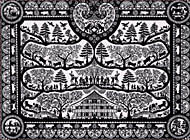Switzerland in silhouette: the craft of paper cutting

Two exhibitions, currently taking place in Switzerland, highlight a little-known art of paper cutting. The work of 22 contemporary Swiss specialists is on display.
Tiny portrayals of cheese-making, lifelike animal pictures, and snowy forest scenes are on sale until October 22 at the Kurhotel Lenkerhof in Lenk and until October 30 at Hüsy, a cosy alpine restaurant in Blankenburg.
The two exhibitions offer a total of 230 works. Many of the paper cutters have produced traditional black-on-white, symmetrically cut scenes of alpine life – dancing villagers, triumphant hunters and cows parading up to their mountain pastures.
Other pictures are modern, like Bruno Pfeiffer’s floral abstractions or Bruno Weber’s stark winter landscapes.
What these works have in common is their scissors or knife skills. In addition, many of their creators were born in the Saane river valley where the exhibitions are being held.
Their particular style of paper cutting began in the same region almost 200 years ago.
It is only a short distance from Blankenburg to Chateau d’Oex, where the Museum of Folk Art displays a roomful of paper cuts by Johann Jakob Hauswirth, the man responsible for this traditional Swiss handicraft.
Hauswirth was a day-labourer who sought work from village to village on the alpine border between Berne and Vaud. Using whatever scraps he could find, including bits of wallpaper and sweet wrappers, he cut paper to depict local scenes and gave them as gifts to the people who fed and housed him.
After Hauswirth’s death in 1871, his paper cutting style was taken up first by a Rougemont postman, Louis Saugy, and then by others until it became a popular pastime in the Saanen area.
The art form is today known and practiced throughout Switzerland. Chief among its supporters is Fritz Hobi, formerly director of the Winterthur handicrafts museum and current president of the Swiss Association for the Friends of Paper Cutting (or SVFS in German).
“Most of today’s paper cutters are hobbyists using traditional styles and themes,” says Hobi, “and they are often extraordinarily skilled. But there are at least 10 cutters who I think everyone would agree are artists rather than artisans.”
One of the “top 10” is Ueli Hofer, who lives in Trimstein near Berne and has had his work shown in New York’s Cooper-Hewitt Museum. Another is Ernst Oppliger, whose latest paper cuts can be seen until October 29 at the Kultur-Spycher in Meikirch, north-west of Berne.
One of the most passionate collectors of work by Hofer, Oppliger and other paper cutters is a surveyor, Niklaus Wyss.
To keep the craft alive and support those who do it, Wyss and his son Christoph started the Swiss Association for the Friends of Paper Cutting in the 1980s. Since 1986, the SVSF has organised regular regional and national exhibitions.
Using earnings from the commissions on exhibition sales, the SVFS has bought outstanding contemporary paper cuts for its collection, which has grown to over 100 works.
“There was a boom in paper-cutting between 1910 and 1920, but we have no samples of that work today,” Wyss told swissinfo. “That mustn’t happen again. Now paper cutting is booming once more, and the SVFS’s collection will document this current period of activity for future enthusiasts.”
The association’s next national paper cutting exhibition will be in Burgdorf in 2002.
by Kim Hays

In compliance with the JTI standards
More: SWI swissinfo.ch certified by the Journalism Trust Initiative
You can find an overview of ongoing debates with our journalists here . Please join us!
If you want to start a conversation about a topic raised in this article or want to report factual errors, email us at english@swissinfo.ch.